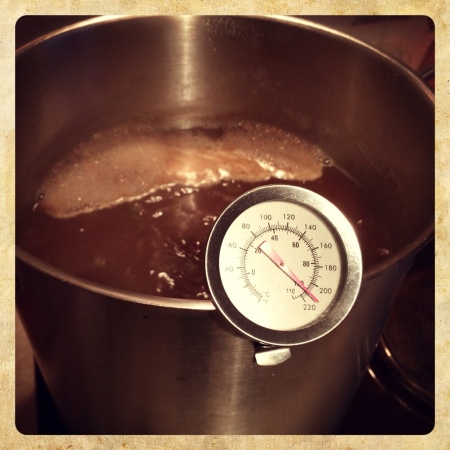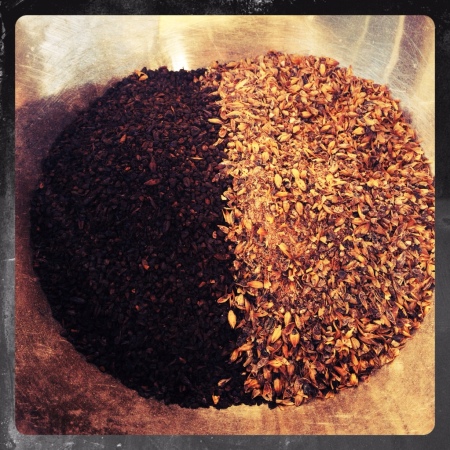
So much for 2014 being the year of the session beer! This is the second barleywine I’ve done in a week! 🙂
This was a spur of the moment brew, because I had a couple of bottles of yeast slurry from the Chasing Tail Pale Ale that I didn’t want to go to waste. I’ve wanted to do a barleywine for ages now, and I figure that if I’m getting my keg system on the go this summer, I’ll have plenty of bottles doing nothing. What better way to utilise them than to start off an archive of “stock” ales. I decided to using the Big Dawg Imperial Amber as the basis for this barleywine. I’ll be using the same amounts of specialty malts, but obviously the gravity will be much higher on this beer, which will necessitate a lot more base malt. The only substitution I’ll be making will be subbing the chocolate malt with the pale version. In order to fit in with style guidelines, I want to make sure I don’t get too much roastiness and keep the dark colour in check.
Recipe
Boil Size: 25.40 l
Post Boil Volume: 23.40 l
Batch Size (fermenter): 19.00 l
Bottling Volume: 17.00 l
Estimated OG: 1.090 SG
Estimated Color: 26.0 EBC
Estimated IBU: 96.3 IBUs
Brewhouse Efficiency: 60.00 %
Est Mash Efficiency: 75.6 %
Boil Time: 60 Minutes
Ingredients
5.600 kg Pale Malt, Maris Otter (5.9 EBC), 71.8 %
0.400 kg Caramel/Crystal Malt – 40L (78.8 EBC), 5.1 %
0.200 kg Wheat Malt, Ger (3.9 EBC), 2.6 %
0.150 kg Biscuit Malt (45.3 EBC), 1.9 %
0.050 kg Caramel/Crystal Malt -100L (197.0 EBC), 0.6 %
0.050 kg Pale Chocolate Malt (591.0 EBC), 0.6 %
1.000 kg Light Dry Extract (15.8 EBC), 12.8 %
35 g Columbus [15.90 %] – Boil 60.0 min, 70.7 IBUs
0.350 kg Corn Sugar (Dextrose), 4.5 %
0.50 Items Whirlfloc Tablet (Boil 15.0 mins)
30 g Cascade [9.20 %] – Boil 15.0 min, 8.5 IBUs
30 g Summit [16.80 %] – Boil 15.0 min, 17.1 IBUs
71 g Cascade [9.20 %] – Boil 0.0 min, 0.0 IBUs
22 g Summit [16.80 %] – Boil 0.0 min, 0.0 IBUs
1.0 pkg Safale American (DCL/Fermentis #US-05) (500ml slurry from Chasing Tail Pale Ale)
Mash Schedule: Bubbles’ Single Infusion, Full Body, Batch Sparge
Total Grain Weight: 7.800 kg
Mash In Add 18.06 l of water at 74.6 C 68.0 C 60 min
Sparge: Batch sparge with 2 steps (Drain mash tun, , 14.30l) of 77.0 C water
Mash Day 20/04/2014 – Mashed at 67.8C, a bit higher than my intended target. But mashed for 90 minutes, and decided to leave the wort in two FVs for boiling the next morning. Wort is an amazing colour, and great aroma. Just a little bit of roast there. Can’t wait to layer some big American hop flavour on top of this monster of a beer.
Brew Day – 21/04/2014 – A LOT of trub into the fermenter. Think I used a good bit more Whirlfloc than usual and ended up with masses of cold break. So it all got stirred up when I was helping it through the hop blocker. I also had very little hops in the boiler because I was using two muslin bags. It might have back-fired on me doing this as there was no hops to filter the break material. Chilled to about 18C before pitching yeast and not only had fermentation kicked off with a few hours, but it’s threatening to escape the fermenter. I probably massively overpitched, but I’m hoping that won’t do any harm in a beer as big as this. Got about 18.5 litres at 1.092, just slightly higher OG than my intended target. Smells great, though I’m concerned about all that trub.
10/05/2014 – Was worried that the fermenter smelled too yeasty, so I took a sample out and tasted. Absolutely bonkers bitterness, massive resiny hop character. Plenty of American hop citrus there, but a little drowned out by the assault of bitterness. I’d planned on dry-hopping, but I didn’t have any Cascade and figured dry-hopping would add very little given the long aging period. Decided to bottle straight away. I had a batch priming solution ready to go and forgot about it! Racked straight into the bottles! So I used carb drops, which will not give the measured level of carbonation I expect these days, but hopefully it will come out well. One carb drop for each 500ml bottle. Got 22 x 500ml bottles from the batch. Recorded a FG of 1.020, which is an excellent level of attenuation, giving an ABV of 9.6%. Even though both my OG and FG figures were just slightly off, my intended ABV was spot-on in the end.
I also racked almost 5 litres into a demi-john and added 15g of American medium-toast oak chips. The oak chips had been sanitised by steaming in a colander for about 10 minutes. I was going to toss them in straight from the bag, but I chickened out. Probably a wise move. The smell from the oak chips was amazing. Can’t wait to do more experiments with oak. Will bottle the oaked version in about 2 weeks time.
13/09/2014 – Thought it might be a bit early for a sample of this, but already it tastes absolutely fantastic. So much for cellaring this, I can’t see it lasting too long. I was concerned that it wouldn’t be dark enough because I subbed the chocolate malt with pale chocolate, but the colour is perfect. Amazing blend of toasty malt and hops. No hot alcohols, but there’s no mistake that it’s a barleywine you’re drinking. I had a bottle of 2011 Bigfoot during the week and the quality of this home brew is right up there with one of the best commercial examples of the style. Very pleased.
18/09/2014 – Opened a bottle of this at a meet this evening which was a little disappointing due to the fact that it was under-carbonated. The low carbonation makes the beer more sweet and cloying. It also lessens the hop impact a bit too. I hope they’re not all like this one! Definitely going to do a re-brew of this in the next few months.
02/11/2014 – Extremely disappointed to find that the oaked version of this beer is absolutely flat as a pancake! And the heartbreaking thing is that the flavour is amazing, at least as far as I can tell in a completely flat beer. The level of oak is really good, and melds well with the hop and dark malt flavours. I don’t really want to just chuck this batch away, so I’m going to attempt to re-seed and maybe even re-carb the oaked portion of the barleywine batch, as well as some of the regular, unoaked barleywine.
24/02/2015 – Quick update on this. Great recipe, great beer, but woefully under carbonated. The key to doing a barleywine like this is getting a good level of carbonation to make the body seem lighter. I ended up dumping all of the oaked batch, because it wasn’t carbonated at all. I’ve dumped a lot of the regular barleywine too – it’s alright for a few sips but quickly becomes overwhelming because of the low carbonation. I think I have a couple of bottle left though, which I’ll use to plan a re-brew of this recipe.



